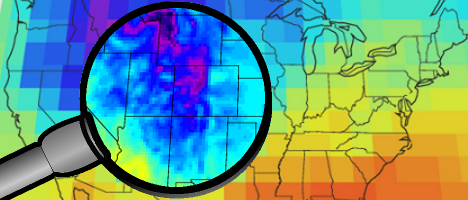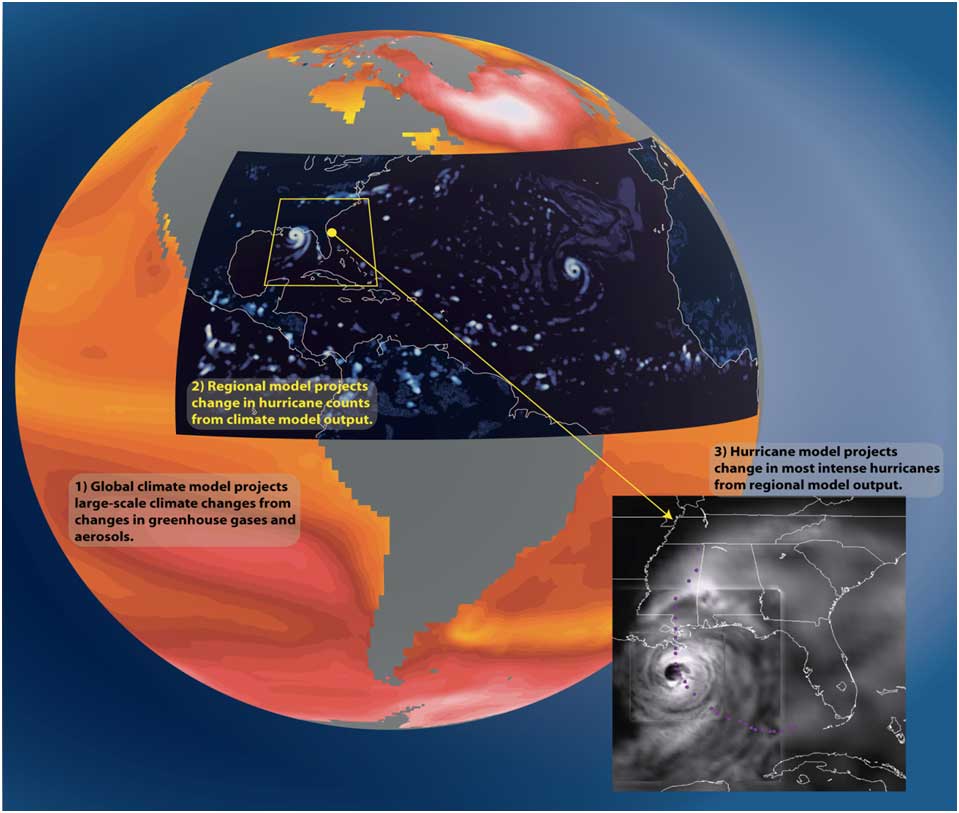Climate Model Downscaling

Contacts, for more information:
Global Climate Models (GCMs) continue to yield important scientific insights into the dynamics and evolution of the climate system on time scales ranging from months to centuries. Outputs from GCMs have also played a key role in informing diverse assessments of the impact of large-scale climate variation and change on natural resources, human health, infrastructure and commerce. Raw GCM output, however, is not always adequate to address the inter-disciplinary questions of interest to stakeholders. Two primary impediments to impacts studies are the spatial scales represented by the GCM may not be as fine as the end-use application requires, and the GCM raw output is deemed to contain biases relative to observational data, which preclude its direct use in downstream applications.
Over time, high-resolution GCMs and advances in model formulation will reduce these impediments, but the myriad of climate impacts questions makes it unlikely that even these improved models will be able to effectively address all scales and applications of interest. A variety of downscaling methods may be used to process and refine GCM output with the aim of producing output more suitable for impacts studies. The refined output aims to address the limitations of coarse resolution and/or regional biases in the GCM output.
Downscaling techniques can be divided into two broad categories: dynamical and statistical. Dynamical downscaling refers to the use of high-resolution regional simulations to dynamically extrapolate the effects of large-scale climate processes to regional or local scales of interest. Statistical downscaling encompasses the use of various statistics-based techniques to determine relationships between large-scale climate patterns resolved by global climate models and observed local climate responses. These relationships are applied to GCM results to transform climate model outputs into statistically refined products, often considered to be more appropriate for use as input to regional or local climate impacts studies.
GFDL Research
Dynamical Downscaling
GFDL scientists are engaged in diverse efforts to apply, improve, and develop downscaling approaches. Figure 1, for example, illustrates how a series of nested atmospheric models of increasing resolution were applied to study the linkage between large-scale climate change drivers and North Atlantic Hurricane frequency, intensity, and associated rainfall (link to research highlight). Similar approaches are now being developed in collaboration with coastal ocean modelers in order to understand the influence of large-scale climate on coastal ecosystems. Efforts are also underway to develop grid nesting and stretching capacity within GFDL’s models.
The strength of these dynamical downscaling applications is their reliance on explicit representations of physical principals (e.g., the laws of thermodynamics and fluid mechanics) that are expected to hold under climate change, but they can be sensitive to large-scale biases and are computationally expensive – successful applications are thus intrinsically linked to GFDL’s global model development efforts and computational resources.
Figure 1: Illustration of dynamical downscaling applied by GFDL scientists to understand the impacts of global climate change on hurricane frequency, intensity and associated rainfall in the North Atlantic. The global field depicts projected sea surface temperature changes from an ensemble of global climate models (~100-200 km grid spacing). This resolution is not fine enough to resolve hurricanes. The second grid is from an 18 km implementation of GFDL’s regional atmospheric model. Bright colors correspond to high clouds associated with storms. This resolution simulates hurricanes, but cannot recreate the strongest (category 4 or 5) storms. The final mesh is GFDL’s operational hurricane forecast model, which features a 9 km grid that moves with the storm and can simulate intense category 4 and 5 hurricanes. Further details can be found in Bender et al. (2010) and Knutson et al. (2013).
Statistical Downscaling
On the statistical side, GFDL scientists are applying high-resolution climate models to assess the limitations of widely applied statistical downscaling approaches, and develop improved approaches. Reliance on statistical downscaling and bias correction techniques to assess fine-scale climate change impacts requires the assumption that the statistical relationships used to transform global climate model output hold for the novel environments expected under climate change. Since these novel environments cannot be observed directly, high-resolution GCM’s provide an important test-bed for understanding the limitations of these approaches. Further details of the scope of GFDL’s efforts in this area can be found here.
Research Highlights
Related Links
- Evaluating empirical-statistical downscaling approaches in a changing climate
- Grid nesting development in the GFDL atmosphere dynamical core
- High resolution atmospheric modeling at GFDL
- High resolution global climate simulations at GFDL
- GFDL’s operational hurricane forecast model
- Climate extremes theme page





